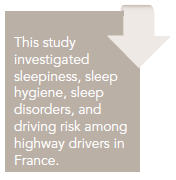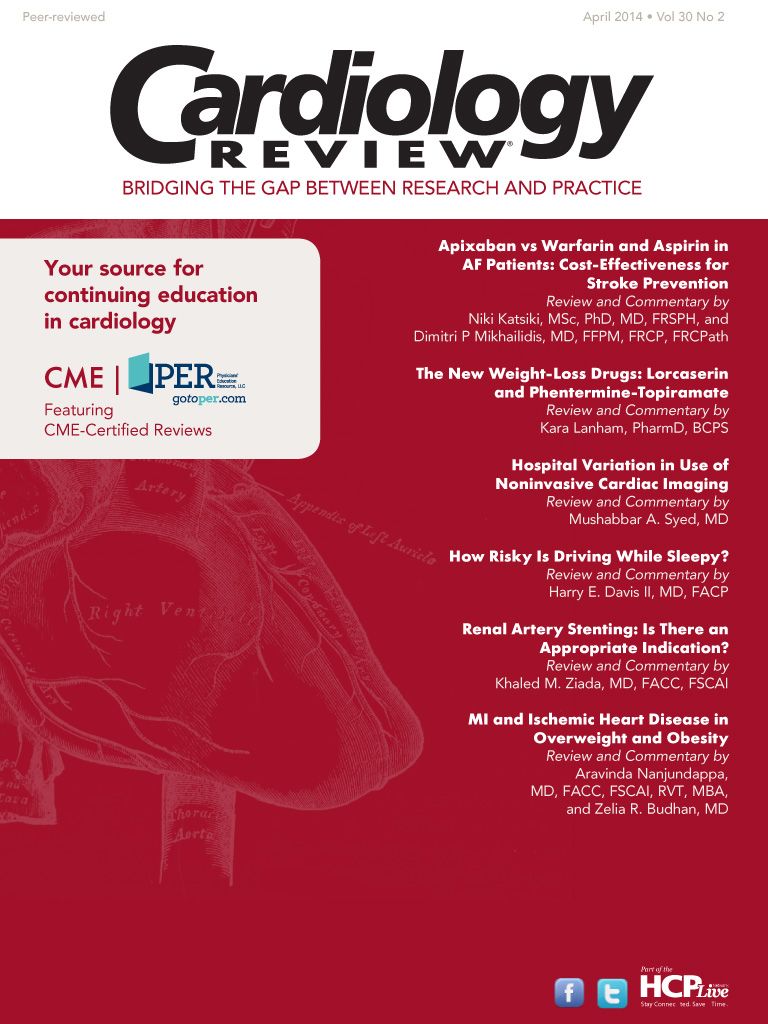How Risky Is Driving While Sleepy?
Researchers investigated the effects of sleepiness, sleep hygiene, sleep disorders, and driving risk among highway drivers in France.

Harry E. Davis II , MD, FACP
Review
Salva MAQ, Barbot F, Hartley S, Sauvagnac R, et al. Sleep disorders, sleepiness, and near-miss accidents among long-distance highway drivers in the summertime. Sleep Med. 2014;15:23-26.

Salva et al1 describe the concern about traffic accident—related morbidity and mortality in France that has led to road-safety campaigns. These campaigns have been focused on reduction of factors known to affect driving performance, such as excessive speed and the use of alcohol and other substances known to affect driving performance. Efforts to address sleepiness and driver fatigue have included the creation of billboards and rest areas to reduce the monotony of long drives and encourage drivers to obtain enough sleep, to rest before long trips, and to start trips during the day. While this has been associated with a gradual decrease of nearly 50% in the number of automobile accidents from 2001 to 2011, the reported 3,970 road deaths in 2011 prompted the researchers to investigate factors associated with sleepiness and accident risk.
The study was designed to evaluate these factors by surveying drivers on high-volume travel days in July 2011 at a highway tollbooth near Tours, France. Drivers were stopped at random by highway patrol officers and invited to participate in an anonymous questionnaire survey. The survey was administered by trained investigators independent of the law-enforcement services and required a maximum of 15 minutes. Drivers participated on a strictly volunteer basis. During the study period, 322,369 cars went through the tollbooths. About 1% of the drivers were invited to participate in the study and 80% of those invited (3051) agreed. Data recorded included sex, age, weight, height, marital status, occupation driving habits, and use of alcohol, cigarettes, coffee, and other caffeinated beverages and medications. Sleep-specific data included the estimated sleep needs and total sleep time in the past 24 hours as well as the usual sleep time during the workweek and on weekends. Acute sleep debt was calculated as the mean sleep time per workweek night minus the sleep time in the past 24 hours. In addition, information on subjects’ sleepiness and sleep complaints was obtained using recognized sleep-evaluation instruments. The interviewers then determined if the drivers had experienced severe sleepiness during the current trip, leading to a near-miss sleepy accident (NMSA), an NMSA in the past year, or a sleepiness-related accident in the past year.
The mean age of the study participants was 46 ± 13 years; 75% of the drivers were men. The total driving distance for the current trip was 330 km ± 226 km. The data suggested that July is a major time for vacation in France. Of the 3051 participants in the study, almost 85% of the drivers were on vacation. A key finding of the study was that 2.9% of drivers reported at least 1 NMSA during a long trip in the summertime.
Analysis revealed 4 factors associated with NMSA: NMSA in the past year (odds ratio [OR], 3.4; 95% confidence interval [CI], 1.7-6.4), nonrestorative sleep in the past 3 months (OR, 1.9; 95% CI, 1.0-3.6), snoring in the past 3 months (OR, 2.0; 95% CI, 1.1-3.7), and sleepiness during the interview (OR, 1.4; 95% CI, 1.2-1.6). Drivers who reported an NMSA during the current trip had a 2.6-fold increase in sleep-related accidents in the past year compared with drivers without a current NMSA. However, the risk for NMSA was not affected by the time of departure, duration of driving, or total sleep time in the 24 hours before the interview. The authors suggest that this may be related to the fact that the majority of the drivers were on vacation plus the possible success of road-safety campaigns in raising awareness about the risks associated with sleepiness at the wheel. However, they express concern about the possible contribution of organic sleep disorders such as obstructive sleep apnea (OSA) syndrome to driving risk. The authors conclude that raising awareness about the risks of chronic sleepiness while driving remains a major challenge for road safety campaigns. They also call for studies of sleep-related breathing disorders, an area not addressed in the current study.
CommentarySleep Habits Should Be Part of Health Promotion Practices
In an effort to uncover accident prevention strategies, Salva et al surveyed highway drivers to identify factors associated with sleepiness and accident risk. Surprisingly, their findings indicate that acute sleep loss (at least in this vacation-time survey) is not a key factor in sleepiness at the wheel. Their study does show a significant risk for highway accidents associated with sleepiness while driving. They found that nonrestorative sleep and snoring were also independently associated with NMSA, suggesting a possible association between the OSA syndrome and sleepiness-related car accidents, and conclude that further studies to investigate this should include an examination of sleep-related breathing disorders or nonrestorative sleep as possible culprits.
Concern about sleep-related breathing disorders and driving risk was the focus of a recent update of an American Thoracic Society (ATS) clinical practice guideline.2 This statement addressed sleep apnea, sleepiness, and driving risk in noncommercial drivers. It noted that OSA is the most common medical disorder that causes excessive daytime sleepiness. However, inattentiveness, fatigue, and sleepiness are being increasingly recognized as contributing factors. Nevertheless, the update focused on the recognition and management of OSA for the purpose of reducing driving risk associated with sleepiness. The ad hoc committee that prepared the statement reviewed the literature to look for the effects of continuous positive airway pressure (CPAP) on crash-related mortality, real crash rate, near crash rate, or driving performance in patients with confirmed OSA. They concluded that CPAP is warranted in patients with OSA and recommended it to reduce driving risk. However, for patients with clinically suspected but unconfirmed OSA, empiric CPAP was not recommended, pending the needed evaluation. While this guideline focus on OSA leaves other causes of daytime sleepiness to be addressed, a strong association between excessive daytime sleepiness and increased near-misses has been shown.3 The authors of the ATS update would agree with the need for further studies to evaluate the impact of sleep-related breathing disorders as suggested by Salva et al. In fact, they identified a number of opportunities for further inquiry and research, including study of the high-risk driver with sleep apnea, the magnitude of expected benefit of treating OSA relative to other driving risks, assessment of the competency of pulmonary practitioners in the assessment and prevention of drowsy driving, and education on health effects of sleep to include educational tools for reducing drowsy driving in populations of patients as well as for the public at large.
It is possible that the study by Salva et al may be unduly influenced by the preponderance of vacationing drivers who were not under work-related time pressures and the selection of daytime drivers for questioning. However, self-reported sleepiness has been shown to be predictive of an increase in the risk of motor vehicle crashes in other drivers.4 This suggests that consideration of sleep habits and daytime sleepiness of our patients should be part of health promotion and disease prevention efforts. It reminds us that this component of history taking should be addressed on a routine basis and may be considered to be included as key components of meaningful use data.5,6 Pending the results of studies of sleep related disorders and their relation to driving accidents, patients suspected of OSA should be asked about daytime sleepiness, especially about falling asleep unintentionally during daily activities and any history of unintended motor vehicle crashes or near misses attributable to sleepiness, fatigue, or inattention.
In a previous review7 the contribution of personal habits such as eating, drinking, smoking, sleeping 7 to 8 hours a night, and exercise to health status and long-term survival was noted to be a key component of disease prevention. The study by Salva et al provides another perspective on the contribution of sleep to health status, specifically to accident prevention, and raises an awareness of the risks associated with sleepiness at the wheel. While the vacation-oriented data of their study do not address other factors associated with sleepiness at the wheel, such as nighttime or work-related driving, this awareness does support an increase in our sensitivity to the need for reducing these risk and warrants the inclusion of this issue as an important component of preventive health care.
References
1. Salva MAQ, Barbot F, Hartley S, et al; Sleep disorders, sleepiness, and near-miss accidents among long-distance highway drivers in the summertime. Sleep Med. 2014;15:23-26.
2. Strohl KP, Brown DB, Collop N, et al; on behalf of the ATS Ad Hoc Committee on Sleep Apnea, Sleepiness, and Driving Risk in Noncommercial Drivers. An Official American Thoracic Society Clinical Practice Guideline: sleep apnea, sleepiness, and driving risk in noncommercial drivers: an update of a 1994 statement. Am J Respir Crit Care Med. 2013;187:1259-1266.
3. Ward KL, Hillman DR, James A, et al. Excessive daytime sleepiness increases the risk of motor vehicle crash in obstructive sleep apnea. J Clin Sleep Med. 2013;9:1013-1021.
4. Ozer C, Etcibasi S, Ozturk L. Daytime sleepiness and sleep habits as risk factors of traffic accidents in a group of Turkish public transport drivers. Int J Clin Exp Med. 2014;7:268-273.
5. Blumenthal D, Tavenner M. The “meaningful use” regulation for electronic health records. N Engl J Med. 2010;6:501-504.
6. DesRoches CM, Audet AM, Painter M, Donelan K. Meeting meaningful use criteria and managing patient populations: a national survey of practicing physicians. Ann Intern Med. 2013;158:791-799.
7. Davis H, Is there something to be said for eating breakfast daily? Cardiol Rev. 2013;29(5).
About the Author
H
arry
E. D
avis
II
, MD, FACP,
is Associate Professor of Medicine and Vice Chair for Education in the Department of Internal Medicine, Texas Tech University Medical Sciences Center, El Paso, TX. Dr. Davis received his medical degree from West Virginia University in Morgantown, WV, and did his internal medicine residency at Philadelphia General Hospital in Philadelphia, PA, and Letterman Army Medical Center in San Francisco, CA. He has practiced medicine with the US Army in many capacities, including Chief of Emergency Medicine at Madigan Army Medical Center, Fort Lewis, WA, Division Surgeon in the 1st Infantry Division, Fort Riley, KS, and as Commander of the 131 Field Hospital/Chief Medical Officer with the UN Forces in Port-au-Prince, Haiti. Dr. Davis has received numerous honors and awards for service and teaching.
